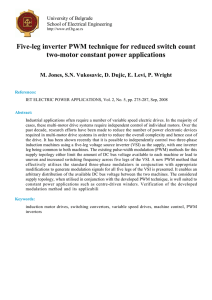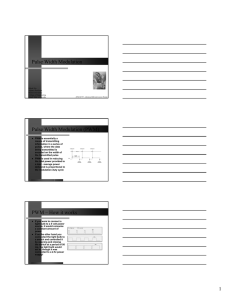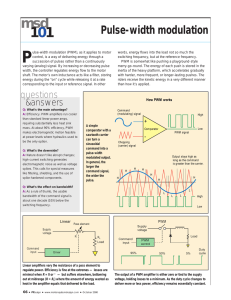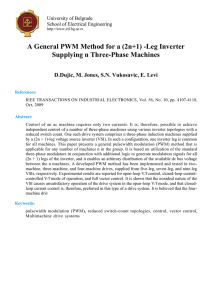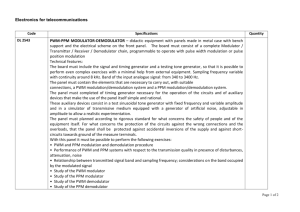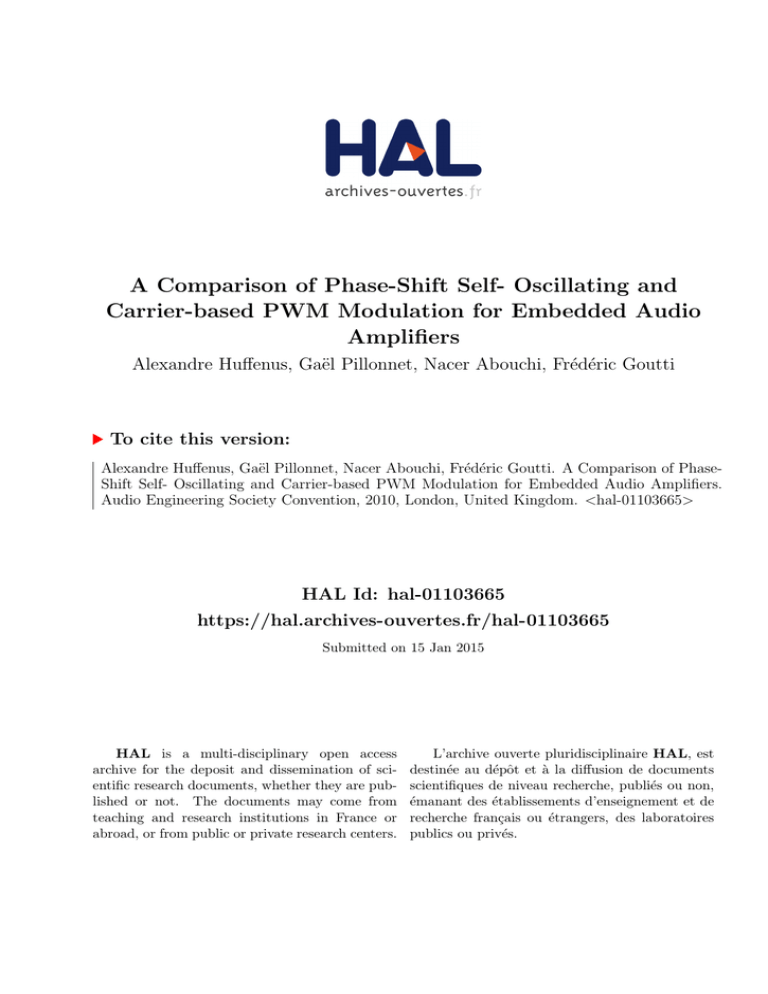
A Comparison of Phase-Shift Self- Oscillating and
Carrier-based PWM Modulation for Embedded Audio
Amplifiers
Alexandre Huffenus, Gaël Pillonnet, Nacer Abouchi, Frédéric Goutti
To cite this version:
Alexandre Huffenus, Gaël Pillonnet, Nacer Abouchi, Frédéric Goutti. A Comparison of PhaseShift Self- Oscillating and Carrier-based PWM Modulation for Embedded Audio Amplifiers.
Audio Engineering Society Convention, 2010, London, United Kingdom. <hal-01103665>
HAL Id: hal-01103665
https://hal.archives-ouvertes.fr/hal-01103665
Submitted on 15 Jan 2015
HAL is a multi-disciplinary open access
archive for the deposit and dissemination of scientific research documents, whether they are published or not. The documents may come from
teaching and research institutions in France or
abroad, or from public or private research centers.
L’archive ouverte pluridisciplinaire HAL, est
destinée au dépôt et à la diffusion de documents
scientifiques de niveau recherche, publiés ou non,
émanant des établissements d’enseignement et de
recherche français ou étrangers, des laboratoires
publics ou privés.
Audio Engineering Society
Convention Paper
Presented at the 128th Convention
2010 May 22–25
London, UK
The papers at this Convention have been selected on the basis of a submitted abstract and extended precis that have been peer
reviewed by at least two qualified anonymous reviewers. This convention paper has been reproduced from the author's advance
manuscript, without editing, corrections, or consideration by the Review Board. The AES takes no responsibility for the contents.
Additional papers may be obtained by sending request and remittance to Audio Engineering Society, 60 East 42nd Street, New
York, New York 10165-2520, USA; also see www.aes.org. All rights reserved. Reproduction of this paper, or any portion thereof,
is not permitted without direct permission from the Journal of the Audio Engineering Society.
A Comparison of Phase-Shift SelfOscillating and Carrier-based PWM
Modulation for Embedded Audio Amplifiers
1
1
1
2
Alexandre Huffenus , Gaël Pillonnet , Nacer Abouchi and Frédéric Goutti
1
Lyon Institute of Nanotechnology, Villeurbanne, F-69616, France
alexandre.huffenus@cpe.fr
2
STMicroelectronics, Grenoble, F-38000, France
frederic.goutti@st.com
ABSTRACT
This paper compares two modulation schemes for Class-D amplifiers: Phase-Shift Self-Oscillating (PSSO) and
Carrier-Based Pulse Width Modulation (PWM). Theoretical analysis (modulation, frequency of oscillation,
bandwidth…), design procedure, and IC silicon evaluation will be shown for mono and stereo operation (on the
same silicon die) on both structures. The design of both architectures will use as many identical building blocks as
possible, to provide a fair, “all else being equal”, comparison. THD+N performance and idle consumption went
from 0.02% and 5.6mA in PWM to 0.007% and 5.2mA in Self-Oscillating. Other advantages and drawbacks of the
Self-Oscillating structure will be explained and compared to the classical Carrier-Based PWM one, with a focus on
battery-powered applications.
1.
INTRODUCTION
The wide use of switching amplifiers for mobile
applications is greatly influenced by their lower current
consumption and higher efficiency [1]. They however
have linearity limitations, some linked to the widely
used carrier-based PWM modulation. A newer
modulation scheme, Phase-Shift Self-Oscillating, is
presented here and compared to standard PWM.
The principle of operation will be detailed for CarrierBased PWM and Phase-Shift Self-Oscillating in Section
2 and Section 3 respectively. Section 4 will detail the
design and IC implementation of both structures. Their
simulated and measured performances will be shown in
Section 5 and 6 respectively, to show the advantages
brought by the new solution with a focus on audio
performance. Finally, conclusions will be drawn in
Section 7.
Huffenus et al.
2.
A Comparison of Class-D Modulation Schemes
CARRIER-BASED PWM
Carrier-Based PWM modulation [2] relies on the
comparison of an input signal (or error signal in closed
loop configurations) with a high frequency reference
(sawtooth or triangle wave). The result of the
comparison is a square wave which duty cycle is
modulated by the input signal’s amplitude. A low output
impedance buffer amplifies this signal to form the
output PWM signal. After low passing of the output
PWM signal, the high frequency content is removed and
the amplified input signal is recovered. The switching
frequency is constant, at the frequency of the reference
signal. Figure 1 shows the block diagram of such an
amplifier, the modulation’s behavior is illustrated in
Figure 2.
Feedback
Vdd
Error
Audio
Input
Triangle
PWM_out
To Speaker
PWM_mod
Gnd
Figure 1: PWM Amplifier Structure
lower than the slope of the reference signal it is
compared with, otherwise overmodulation will occur.
To prevent this behavior, the loop bandwidth is limited
to fs/pi (usually fs/4 in practice, to keep a safety
margin). This instability is shown in Figure 3.
Verr
Verr
Vref
Stable
Vref
Unstable
Figure 3: Instability in Feedback PWM Amplifiers
The output frequency spectrum resembles the one of a
square wave at the switching frequency, plus sidebands
around every switching frequency harmonic due to the
modulation of the input signal (defined by Bessel
functions) [4]. At audio frequencies, the spectrum of the
input signal is present. No harmonics of the input signal
are present in theory, if just the modulation is
considered, with linear blocks. Figure 4 shows the
theoretical spectrum of a PWM signal, with a sinusoidal
input signal at -6dB FS.
Figure 2: PWM Modulation
Figure 4: PWM Modulation Frequency Spectrum
The errors introduced in the signal path (output stage
non linearities, supply noise, etc) increase the distortion
on the output signal. In order to obtain low THD
figures, a feedback loop is required to correct these
errors.
In a feedback configuration, the loop bandwidth of a
Carrier-Based PWM amplifier is limited for large-signal
stability reasons [3]. The error signal’s slope has to be
AES 128th Convention, London, UK, 2009 May 22–25
Page 2 of 8
Huffenus et al.
3.
A Comparison of Class-D Modulation Schemes
PHASE-SHIFT SELF-OSCILLATING
This newer structure is based on a self-oscillating loop,
as in oscillators’ theory [5]. The modulator, output stage
and feedback filter form gains, poles, possibly zeros and
delays. Figure 5 shows its electrical structure. The block
diagram is in Figure 6 showing the integrating error
amplifier (C(s)), the comparator and output stage (K(s))
and the feedback filter (H(s)).
Feedback
Vdd
times higher than with PWM modulation. At the same
signal frequency, more error correction is applied and a
fourfold decrease in THD can be expected.
A low frequency signal input is added to the loop,
which is able to modulate the duty cycle of the output
waveform as in Carrier-Based PWM. However, selfoscillating modulation does not operate at a constant
switching frequency: the higher the modulation index
the lower the switching frequency, as shows Figure 7.
There is no low-frequency limit, when the amplifier
clips the switching frequency goes down to zero.
Error
Oscillation frequency variation
Vref
PWM_mod
Oscillation frequency, fsw
Audio Input
PWM_out
To Speaker
Gnd
Figure 5: PSSO Oscillating Amplifier Structure
H(s)
1.2
1
0.8
0.6
0.4
0.2
0
0
0.2
0.4
0.6
0.8
1
Modulation index, M
K(s)
C(s)
Ve
Vint
Figure 7: Oscillation Frequency vs. Modulation Index
Vout
Figure 6: PSSO Amplifier Block Diagram
Barkhausen’s criterion defines the oscillation of a
closed-loop system. If its phase equals 360° at a
frequency where the loop gain is unity, oscillations will
occur. The PSSO loop from Figure 6 has a loop gain
and phase as defined by (1) and (2) respectively.
G(f) = H(f)⋅C(f)⋅K(f) =
Ve(f) Vint(f) Vdd
⋅
⋅
Vout(f) Ve(f) Vint(f)
1
∠G(f)=90+∠
+360⋅ f ⋅td
1
+
j
⋅
f
f
c
The output frequency spectrum is the one of a square
wave which frequency varies with time, modulated by
the amplitude of the audio input signal. At low
frequencies, the audio signal can be found. The peak
amplitude of the HF components is lower than with
PWM. This is an advantage when EMI is a concern.
(1)
(2)
The output stage generates a rail to rail square wave at
the switching frequency, the output amplitude of K(f)
equals then Vdd there. This makes the loop gain G(s)
unity at the switching frequency. The oscillation
criterion is then only defined by the loop phase, by the
poles and zeros placement. The loop bandwidth is four
Figure 8: PSSO Modulation Frequency Spectrum
AES 128th Convention, London, UK, 2009 May 22–25
Page 3 of 8
Huffenus et al.
4.
A Comparison of Class-D Modulation Schemes
IC IMPLEMENTATION
Both ICs are implemented in a STMicroelectronics
0.25µm CMOS IC process with thick oxide transistors,
capable of running up to 5.5V. The building blocks
(error amplifier, comparator, MOS drivers and output
stage) are the same for both configurations to make the
comparison as fair as possible.
4.1.
driving both switching legs in opposite phase, they can
be controlled by a 3-level modulation [4]. This reduces
the high frequency content on the output and permits the
use of a smaller output filter, or no filter at all if the
speaker load is inductive enough to provide filtering on
its own. Figure 9 illustrates this 3-level modulation.
Preamplifier
In addition to the Class-D loop, both amplifiers (PSSO
and PWM) are used with a linear (Class-AB)
preamplifier. This fully differential amplifier serves
multiple functions like setting the input impedance,
improving the Common Mode Rejection Ratio
(CMMR) and setting the voltage gain [6].
Figure 9: 2-level (left) and 3-Level (right) Modulation
Components mismatch in this stage, especially on the
input and feedback resistors, limits its Power Supply
Rejection Ratio (PSRR) to about 65dB at low
frequencies. This stage is then the limiting factor for the
complete amplifier’s PSRR, meaning that it will
unfortunately not be possible to compare the PSRR
performance of PWM and PSSO architectures here.
While the implementation of a 3-level PWM
modulation is straightforward [4], a PSSO amplifier
requires a synchronization between both polarities to
maintain them in frequency and phase. Due to
components mismatch between both polarities, they will
not oscillate at the exact same frequencies and the high
frequency content will not be ideally reduced. [7] and
[8] propose a synchronization scheme that does not
increase the system complexity and that functions here
with good results, with a coupling factor K of about 0.1.
4.2.
4.3.
Differential Operation
The single supply rail available in battery powered
applications leads to two possibilities for the load
connection. A single ended output can be used, but
would require a large coupling capacitor to provide a
DC-free output voltage. A bridge configuration is then
preferred, having no DC voltage on its output. Also, its
voltage swing is doubled compared to a single ended
configuration, allowing four times more output power.
This differential configuration allows the use of a
slightly different modulation on the output: instead of
Carrier-Based PWM Amplifier
The amplifier is made of an integrating error amplifier
(comparing input and feedback signals), a comparator
fed by the error signal and the triangle wave, followed
by the MOS drivers and the output stage. Two signal
paths are used, fed by input signals in opposite phase, to
generate a 3-level PWM modulation. The linear
preamplifier is placed in front of the Class-D path, and
an oscillator is required here to provide the sawtooth
reference signal. The signal path for one channel is
illustrated in Figure 10.
Cint
Rfb
Rin
Out
In
Preamplifier
Integrator
Coupling
Comparator
Driver
Figure 10: PWM Amplifier Schematic (one channel shown)
AES 128th Convention, London, UK, 2009 May 22–25
Page 4 of 8
Power Stage
Huffenus et al.
A Comparison of Class-D Modulation Schemes
Cint
RfbA
RfbB
Cfb
Rin
In
Out
Rk
Preamplifier
Integrator
Coupling
Comparator
Driver
Feedback filter
Power Stage
Figure 11: PSSO Amplifier Schematic (one channel shown)
4.4.
Self-Oscillating Amplifier
5.
To form an oscillating loop, the sawtooth signal is
removed and the comparators are connected to a DC
common-mode voltage instead. A pole is added to the
feedback path to increase the phase. With this pole, the
integrator and propagation delays, the required 180° are
achieved at the switching frequency to start oscillations.
SIMULATED PERFORMANCE
The schematics from Figure 10 and Figure 11 have been
simulated and the results are presented in this section.
For the PWM amplifier, Figure 12 shows the behavior
of the modulation. It operates as expected, with a fixed
frequency and a duty cycle controlled by the input
signal.
Figure 11 shows this implementation. RfbA, RfbB and Cfb
form the feedback loop’s pole. RfbA, RfbB and Cint around
the opamp form the integrator and its time constant. The
resistor Rk creates the coupling between the positive and
negative polarities.
With this implementation, only the feedback pole’s
location and the loop delay influence the oscillation
frequency. The integrator’s phase is 90° at all the time
so its time constant has no effect. For performance
reasons it is best to keep the loop delay small, so the
oscillation frequency adjustment is best made with the
feedback pole.
Figure 12: Simulated PWM Modulation
With a stereo amplifier on the same silicon die, a
coupling (via power supply rails, substrate,
capacitive…) between the two channels is inevitable
and intermodulation will occur at fswleft-fswright. This
intermodulation product will fall down in the audio
band and will be audible. In order to prevent this, the
left channel and right channel oscillation frequencies
have been offset by 30kHz by using different feedback
pole frequencies.
The simulation results for the PSSO modulation are
illustrated in Figure 13. The system oscillates as
predicted, and there is a frequency variation. The larger
the signal is, the lower the switching frequency
becomes.
AES 128th Convention, London, UK, 2009 May 22–25
Page 5 of 8
Huffenus et al.
A Comparison of Class-D Modulation Schemes
Both versions have a correct 3-level modulation, thanks
to the clocked PWM and the coupling in the PSSO.
Without coupling, the results in Figure 16 are obtained.
Figure 13: Simulated PWM Modulation
One important observation is that the error signal has
lower slopes than with PWM modulation. This is due to
the low pass filter in the feedback network. The
requirements on the error amplifier can then be relaxed
with the PSSO topology, especially on its slew-rate.
With the bridge tied load, the modulation is made 3level as explained in section 4.2. Figure 14 and Figure
15 show the simulated output signals.
Figure 16: PSSO without coupling between polarities
The THD performance of both amplifiers have been
simulated and with Vdd=3.6V, a load of 8Ω and a 1kHz
signal at -6dB the THD is 0.02% for the PWM amplifier
and 0.006% for the PSSO. The PSSO amplifier has a
better THD performance, as predicted.
6.
MEASURED PERFORMANCE
THD+N performance has been measured with an Audio
Precision System2. In mono operation the carrier-based
system achieves a minimum of 0.02% as plotted in
Figure 17 (with Vdd=3.6V, a 1kHz signal and a 8Ω
load) while the self oscillating goes as low as 0.007%.
The improvement is close to the 4:1 ratio expected from
the bandwidth increase and matches the simulations.
10
5
2
Figure 14: Simulated PWM 3-level Modulation
1
0.5
0.2
%
0.1
0.05
0.02
0.01
0.005
0.002
0.001
1m
2m
5m
10m
20m
50m
100m
200m
500m
1
W
Figure 17: THD+N Performance, Mono Operation
Figure 15: Simulated PSSO 3-level Modulation
In stereo, the performance of the PWM amplifier
remains identical but the THD+N increases on the
AES 128th Convention, London, UK, 2009 May 22–25
Page 6 of 8
Huffenus et al.
A Comparison of Class-D Modulation Schemes
PSSO amplifier as shown in Figure 18. Simulations did
not predict this phenomenon, so its source is quite likely
a parasitic coupling between the two channels when the
output current increases, like a coupling through the
substrate or the bonding wires. Further investigation
with a different layout is required to precisely determine
the origin of this effect.
Parameter
Output Noise, µV
PSRR 217Hz, dB
Icc 5V, mA
PWM
27
65
5.6
Fsw, kHz
280
PSSO
27
65
5.2
275 (Left)
310 (Right)
Table 1: Measured Performance
10
5
2
1
Noise performance is identical, showing that it is
determined by the thermal (white) and flicker (1/f) noise
of the analog circuits as opamps ant the like. The type of
modulation used has no visible effect on the output
noise.
0.5
0.2
%
0.1
0.05
0.02
0.01
0.005
0.002
0.001
1m
2m
5m
10m
20m
50m
100m
200m
500m
1
The gain in current consumption, 8%, is due to the
oscillator bock that has been removed.
W
Figure 18: THD+N Performance, Mono vs. Stereo
An interesting discrete implementation of a selfoscillating Class-D amplifier [9] shows a solution by
locking the modulator to a reference frequency for idle
and low modulation indexes. However, a clock
generator is required again and the THD+N
performance is degraded.
The proper behavior of the coupling between both
polarities, in the PSSO amplifier, is illustrated in Figure
19. The positive and negative outputs are plotted during
idle. Both signals have the same frequency and phase,
the differential signal seen by the load is then zero.
OUT+
7.
The evaluation of both modulation schemes showed that
the newer self-oscillating one brings a series of
advantages compared to fixed-frequency PWM.
Theoretical analysis and measurement results showed
THD+N improvements and idle current reduction,
which is especially interesting in battery-powered audio
systems. In terms of output frequency spectrum, the
variable switching frequency of the self oscillating has
the advantage of spreading the energy over a frequency
range, but could complicate the integration with other
switching devices when each of them should occupy a
specific frequency band. Specific considerations to
obtain a correct 3-level modulations have been shown,
as well as the sensitivity of this topology to the use of
multiple channels on the same silicon IC.
8.
OUT-
CONCLUSION
ACKNOWLEDGEMENTS
This work was supported by STMicroelectronics
Grenoble and by French Région Rhone-Alpes “Nano
2012” R&D program.
Figure 19: PSSO Outputs at Idle
Other performances are given Table 1, comparing
Carrier-Based PWM (left column) to Phase-Shift SelfOscillating (right column). Measurements have been
performed at Vdd=5V with a 1kHz input signal, an 8Ω
and a gain of 6dB unless otherwise mentioned.
9.
REFERENCES
[1] J.D. Martin, “Theoretical efficiencies of Class-D
Power Amplifiers”, Proc. IEE., Vol . 117, pp. 10891090, 1970.
AES 128th Convention, London, UK, 2009 May 22–25
Page 7 of 8
Huffenus et al.
A Comparison of Class-D Modulation Schemes
[2] J. Vanderkooy, “New Concepts in Pulse-Width
Modulation”, presented at the 97th AES
Convention, San Francisco, USA, 1994 Nov. 10-13.
[3] M. Berkhout, “Class-D Audio Amplifiers in Mobile
Applications”, IEEE Internationnal Synopsium on
Circuit and Systems, pp. 1169-1172, May 2009.
[4] K. Nielsen, “A Review and Comparison of Pulse
Width Modulation (PWM) Methods for Analog and
Digital Input Switching Power Amplifiers”,
presented at the 102nd AES Convention, Munich,
Germany, 1997 March 22-25.
[5] P.J. Baxandall, “Transistor sine-wave LC
oscillators,” Intern. Conv. On Transistors and
Associated Semicon. Devices, IRE Proc. B, pp.
748-759, May 1959.
[6] STMicroelectronics, TS4962 Datasheet.
[7] T. Piessens, M. Steyaert, “Oscillator Pulling and
Synchronisation Issues in Self-Oscillating Class D
Power Amplifiers”, Proceedings of the 29th
European Solid-State Circuits Conference, pp. 529532, Sept. 2003.
[8] L. Soo-Hyoung et al., “A 2W, 92% efficiency and
0.01% THD+N Class-D audio power amplifier for
mobile applications, based on the novel SCOM
architecture”, Proceedings of the IEEE Custom
Integrated Circuits Conference, Oct. 2004.
[9] International Rectifier,
Reference Design Kit.
IRAUDAMP4
Audio
AES 128th Convention, London, UK, 2009 May 22–25
Page 8 of 8

